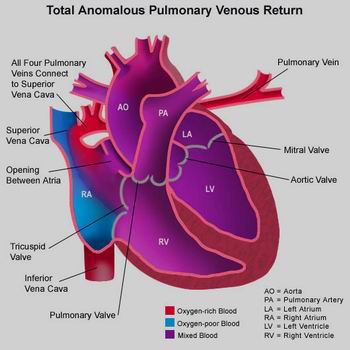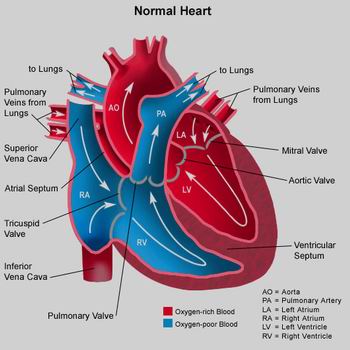Total Anomalous Pulmonary Venous Return (TAPVR)is a congenital heart defect. Due to abnormal development of the fetal heart during the first 8 weeks of pregnancy, the vessels that bring oxygen-rich (red) blood back to the heart from the lungs are improperly connected.

Normally, oxygen-poor blood returns to the right atrium from the body, travels to the right ventricle, and then is pumped through the pulmonary artery into the lungs where it receives oxygen. Oxygen-rich (red) blood returns to the left atrium from the lungs through four pulmonary veins. It then passes into the left ventricle, and is pumped through the aorta out to the body.
In TAPVR, the four pulmonary veins are connected somewhere besides the left atrium. There are several possible places where the pulmonary veins can connect. The most common connection is to a blood vessel that brings oxygen-poor (blue) blood back to the right atrium, usually the superior vena cava.
In TAPVR, oxygen-rich (red) blood that should return to the left atrium, the left ventricle, the aorta, and then the body, instead mixes with the oxygen-poor (blue) blood flowing into the right side of the heart. This situation by itself will not support life, because there is no way for oxygen-rich (red) blood to be delivered to the body.
Other heart defects are often associated with TAPVR, and they actually help the infant with total anomalous pulmonary venous return to live until surgical intervention is possible:
- An opening in the Atrial or Ventricular septum will allow blood from one side to mix with blood from another, creating "purple" blood with an oxygen level somewhere in-between that of the oxygen-poor (blue) and the oxygen-rich (red) blood.
- Patent ductus arteriosus (PDA) will also allow mixing of oxygen-poor (blue) and oxygen-rich (red) blood through the connection between the aorta and pulmonary artery. The "purple" blood that results from this mixing is beneficial, providing at least a little oxygen to the body.
Causes:
The heart is forming during the first 8 weeks of fetal development. The problem occurs during this time, allowing the pulmonary veins to be attached incorrectly. In TA, during the middle of this development period, the tricuspid valve does not develop properly. Ventricular development is influenced by blood flowing through it, and since no blood is able to pass through the tricuspid valve, the right ventricle remains small.
The problem that occurs with TAPVR is that too much blood flows through the blood vessels in the lungs, since the pulmonary veins add extra blood back in to the circulation on the right side of the heart. The lungs become stressed by this extra blood flow, and can eventually become damaged from it.
Symptoms:
The obvious indication of TAPVR is a newborn who becomes blue coloring of the skin, lips, and nailbeds in the first days. The degree of cyanosis is related to the presence of other defects that allow blood to mix.
Babies with large atrial or ventricular septal defects, allowing a mixture of oxygen-rich (red) and oxygen-poor (blue) blood to enter the left heart and go to the body, may have less cyanosis and fewer symptoms at birth. Babies who have a large foramen ovale or a ductus arteriosus that remains open for a while may also present with symptoms a few days or weeks after birth.
The following are the other most common symptoms of total anomalous pulmonary venous. However, each child may experience symptoms differently. Symptoms may include:
- Rapid breathing
- Labored breathing
- Rapid heart rate
- Cool, clammy skin
- Lethargy
- Poor feeding
Diagnosis:
Cyanosis and rapid breathing are major indications that there is a problem with your newborn. Your child's physician may have also heard a heart murmur during a physical examination. A heart murmur is simply a noise caused by the turbulence of blood flowing through the openings that allow the blood to mix.
Other tests needed may include the following:
- Chest X-ray
- Electrocardiogram (ECG or EKG)
- Echocardiogram (echo)
- Cardiac catheterization

Specific treatment for TAPVR will be determined by your child's physician based on:
- The child's age, overall health, and medical history
- Extent of the disease
- The child's tolerance for specific medications, procedures, or therapies
- Expectations for the course of the disease
Postoperative care for your child:
After surgery, infants will return to the intensive care unit (ICU) for a few days to be closely monitored during recovery.
While your child is in the ICU, special equipment will be used to help him/her recover.
After discharged from the ICU, your child will recuperate on another hospital unit for a few days before going home. You will learn how to care for your child at home before your child is discharged. Your child may need to take medications for a while, and these will be explained to you.
Many infants who have had TAPVR surgical repair will grow and develop normally. However, after TAPVR repair, your infant will need to be followed periodically by a pediatric cardiologist who will make assessments to check for any heart-related problems.
As some children grow, the area where the pulmonary arteries were reconnected to the left atrium may become narrowed, preventing blood from moving from the lungs to the left atrium. Treatment may include:
- Placement of a wire mesh device called a stent into the narrowed vein(s) to open it, done during a cardiac catheterization procedure
- Surgical enlargement of the narrowed pulmonary vein connection(s)
Regular follow-up care at a center offering pediatric or adult congenital cardiac care should continue throughout the individual’s lifespan.
The other major Cardiac Surgeries are:
Few Major Hospitals for TAPVR are:
Thailand, Malaysia, Singapore, Turkey and India are the most cost effective locations that offer up to almost 80% savings in comparison to the US.
SurgeryPlanet facilitates a plethora of services to the medical treatment traveler also which includes, a hassle free and discounted travel option, a welcome hand at the airport on arrival, travel in an air-conditioned car, round the clock service & support. Your medical evaluation is pre arranged with the least of waiting time. Once your assessment is complete and found medically fit, the procedure is immediately scheduled without a waiting period. Please read through our Services and Testimonials to understand and select your best options.
Treatment for Aortic Aneurysm surgery | surgeons Aortic aneurysm | Aortic aneurysm | Hospitals for Thoracic Aortic Aneurysms |Surgeons for Thoracic Aortic Aneurysms | Thoracic Aortic Aneurysms | Cardiology | cardiac surgery | cardiac hospitals | Thoracic Aortic Aneurysms surgery India | Thoracic Aortic Aneurysms surgery Thailand | cardio-thoracic surgeons | atherosclerotic plaque | endovascular repair | marfan syndrome | aortic valve | thoracic aorta | AAA repair | dilatation | Doctors for Thoracic Aortic Aneurysms | Aortic Aneurysm surgery recovery | Aortic Aneurysm surgery in Singapore | Thoracic Aortic Aneyursm surgery in Singapore | Aortic Aneurysm surgery in India | Cost of Aortic Aneurysm surgery | Cost of Thoracic Aortic Aneurysm surgery | Aortic Aneurysm surgery Information | Thoracic Aortic Aneurysm surgery information | Hospitals for Aortic aneurysm | Treatment for Thoracic Aortic Aneurysm surgery | Doctors for Aortic aneurysm | Thoracic Aortic Aneurysm surgery recovery
SurgeryPlanet is an Healthcare Facilitator and not a Medical service provider. The information provided in this website is not to be used for diagnosis or treatment of any medical condition or use for any medical purposes. We provide information solely for medical travel facilitation and do not endorse any particular health care provider, hospital, facility, destination or any healthcare service or treatment listed. We are not an agent for, or affiliated to any health care provider, or service listed in our website and is not responsible for health care services provided by them. Choice of hospital or doctor for your healthcare services is your independent decision. Consult your domestic licensed health care provider before seeking the services of any health care provider you learn about from our website.


